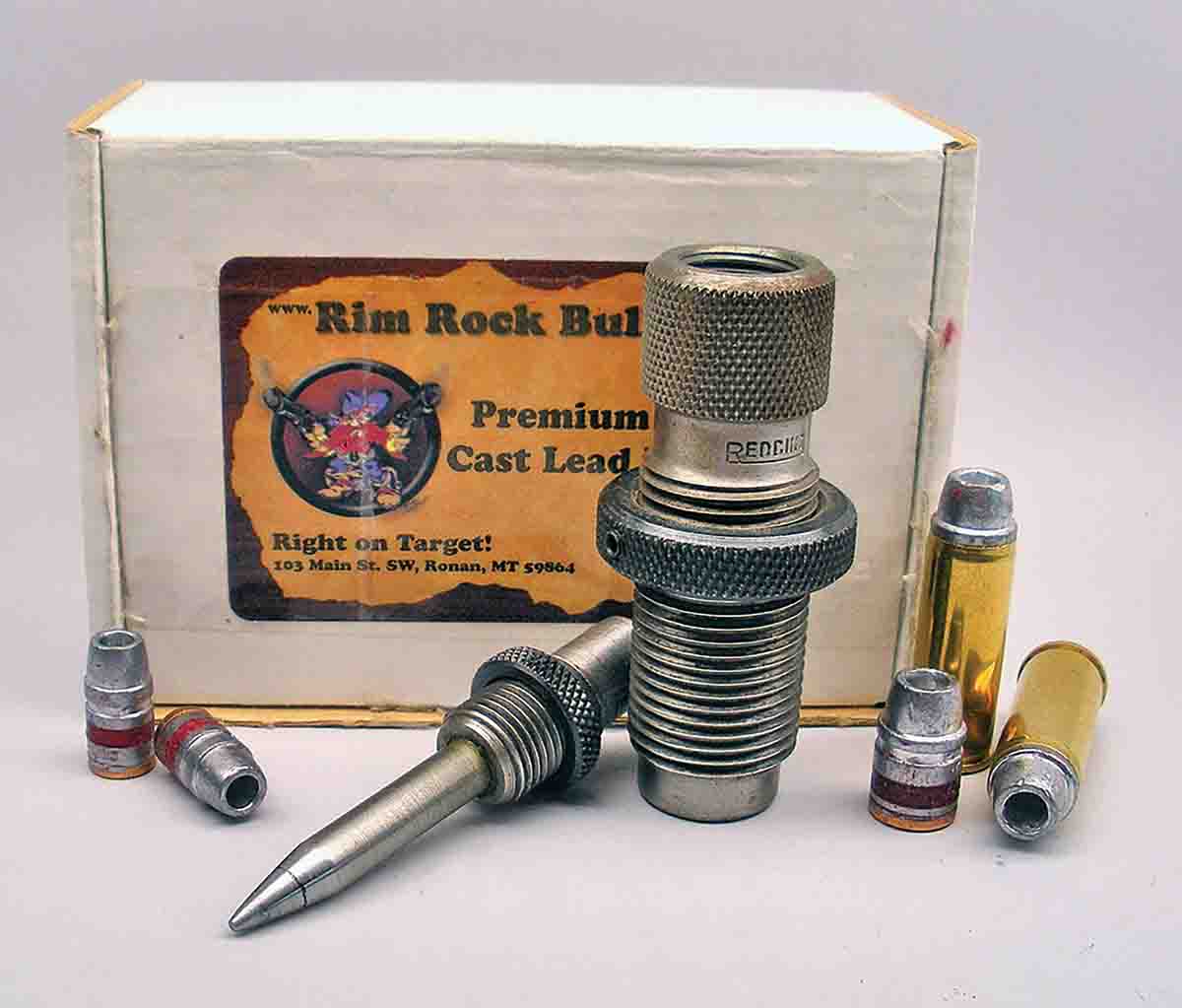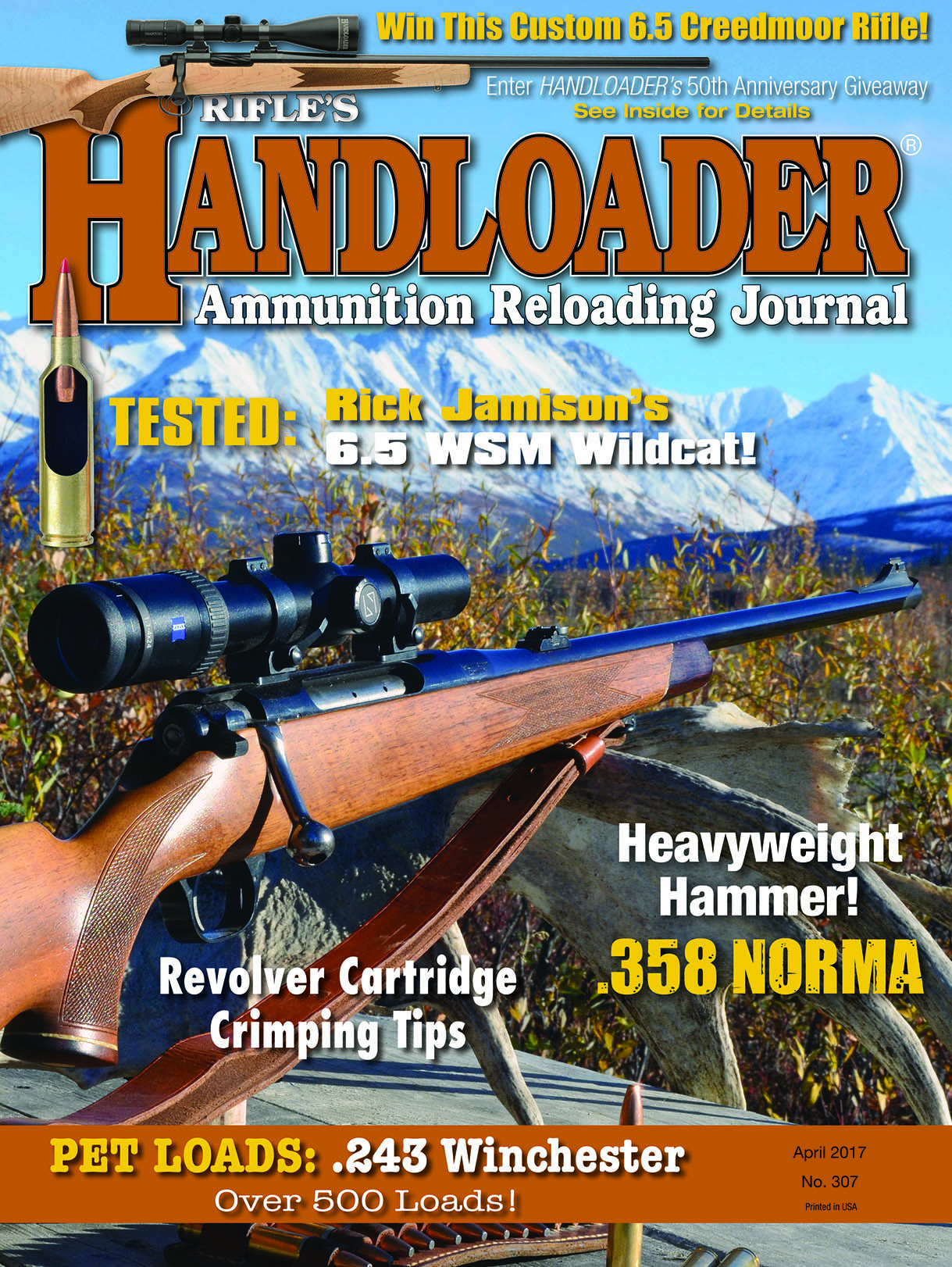Reloader's Press
Seating Hollowpoint Cast Bullets
column By: Dave Scovill |

Speer also sells swaged lead semiwadcutter bullets in .38, .44 and .45 caliber, with the .38s being available as hollowpoints as well. At that time, bullet seating punches supplied with most reloading die sets might fit the nose of one or more bullets, but it was just my luck, apparently, that they rarely fit the bullet I was using. Moreover, if the bullet is not started in the case mouth perfectly straight with the fingers prior to seating in the die, it might be seated and crimped at a slight angle. Sometimes the misalignment is visible, sometimes not.
The underlying problem with all hollowpoints – jacketed, swaged lead alloy or cast semiwadcutters – is the lead alloy used to form the core of a jacketed bullet or the alloy used to form swaged or cast bullets must be soft enough to promote expansion at projected impact velocities. Otherwise, the hollowpoint design is pretty much worthless, with the exception that accuracy is often associated with, or at least more consistent with, a rear weight bias common to hollowpoints, both handgun and rifle bullets.
All of the above was considered a few years ago when ordering a supply of cast hollowpoint gas-check bullets for .38, .44 and .45 calibers in standard weight ranges for each caliber, i.e., 150 to 158, 240 to 250 and 250 to 270 grains, respectively, from Rim Rock Bullets (RRB), 35675 Minesinger Trl, Polson MT 59860. The alloy specified was 1:16 (tin-to-lead), Brinell hardness number (BHN) 11, the same alloy .45-70 government swaged lead bullets were formed with and Elmer Keith melted down for his cast bullets. The problem, from past experience, was that the nose of the relatively soft semiwadcutter-shaped, lead-alloy bullet would be misshaped slightly – the nose flattened and the cavity walls turned in if the correct seating punch was used to seat the bullet in a tight case neck, e.g., .448 inch for .45 caliber and .425 inch for .44 caliber with bullets sized .452 to .454 inch and .430 to .431 inch, respectively.
As it turned out, the hollow- nose cavity in all calibers from RRB were formed with the same cone shape, with the depth of the cavity varying by caliber, i.e., the deepest cavity in the .45 caliber and the shallowest in .38 caliber.
Since the coned-shaped nose cavities were all formed in the bullet mould with the same sized punch, I decided to make a seating punch with the same dimensions used to form the hollow cavity. Sifting through a set of RCBS tapered neck expanding dies revealed the .22 to 7mm die was close enough to work with.
To start, the tapered end of the neck expander die was chucked in an electric drill that was mounted in a large bench vice with padded jaws. With the drill on and used as a lathe, a coarse stone was used to cut through the hardened surface at the large end of the expander to fit in the drill chuck, roughly .477 inch in diameter. Then the expander was removed from the drill, secured in the vice and the tapered area of the die was heated to a dull red with a benzene torch and left to cool at air temperature to anneal the casehardened surface.
Meanwhile, a toothpick was used to measure the depth of the hollow-nose cavity of a .45-caliber cast bullet, and a caliper was used to measure the diameter of the cavity across the nose. The two measurements gave the dimensions of a cone (triangle) that would be the shape of a hollow cavity. Then the expander was mounted in the drill chuck and the drill set at standard speed; a file was used to cut the required shape on the spinning expander.
From there it was basically a matter of fine-turning the angle on the surface of the seating punch with a fine-tooth metal file and provide a snug fit in the cavity of the bullet, then polish with progressively finer 00, 000 and 0000 steel wool. The tapered neck expanding die was already threaded to fit in standard bullet seating dies, so it was easily adjusted to seat the bullets to the proper depth for crimping.
In practice, the bullets were seated in the case necks by hand, and the case was placed in the shellholder. With the press handle lowered, the tapered seating die centered in the hollow-nose cavity of the bullet and pushed it straight down to the required depth for crimping in a separate die.
Since RRB bullets have a flat- bottom crimping groove as opposed to the tapered type found on most cast-bullet designs, the Lee Factory Crimp dies are likely the best choice. The other option is to use the Lyman 310 dies for the caliber of interest to apply the crimp or use the standard crimp die that came with the reloading die set, albeit the tapered-crimp or roll-crimp dies were not made to form the optimum crimp on a flat-bottom crimping groove. The advantage served by the RRB crimp groove is that it establishes a firm crimp over a large area, which appears to be an advantage when using slower-burning powders associated with higher velocities and pressures in magnum-type loads. The jury may not be in just yet, but the heavier, firmer crimp appears to help reduce velocity variations when compared with other crimp groove designs. Tapered neck expanding dies in smaller to medium-sized calibers are available from RCBS, Hornady, Redding, Lee, etc. The .22 to 7mm expander was the smallest on hand and required minimal work to form the bullet seating punch that effectively eliminated the potential for damage when seating jacketed hollowpoint designs or cast hollowpoints, albeit each cavity design would require a separate seating punch. Speer Gold Dot bullets, also with a cone-shaped hollow cavity, would be an excellent candidate for an additional bullet seating punch.


